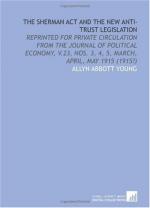|
This section contains 670 words (approx. 3 pages at 300 words per page) |

|
In the United States, toward the last part of the nineteenth century, widespread business combinations known as trust agreements existed. These agreements usually involved two or more companies that combined with the purpose of raising prices and lowering output, giving the trustees the power to control competition and maximize profits at the public's expense. These trust agreements would result in a monopoly. To combat this sort of business behavior, Congress passed antitrust legislation.
In 1890 Congress passed the Sherman Antitrust Act, which forbade all combinations or conspiracies in restraint of trade. The act contained two substantive provisions. Section 1 declared illegal contracts and conspiracies in restraint of trade, and Section 2 prohibited monopolization and attempts to monopolize. When an injured party or the government filed suits, the courts could order the guilty firms to stop their illegal behavior or the firms could be dissolved. The Sherman Antitrust Act pertained...
|
This section contains 670 words (approx. 3 pages at 300 words per page) |

|


